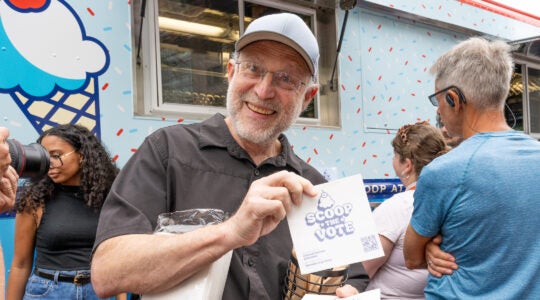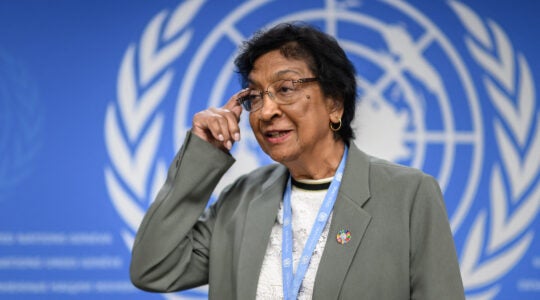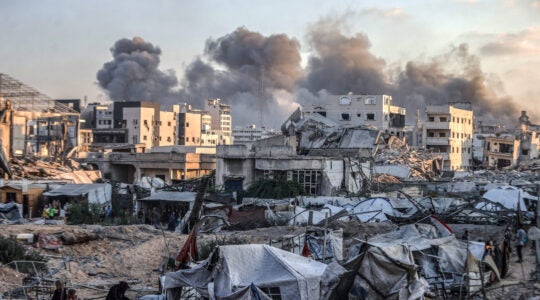JERUSALEM (JTA) – Just days before the holiday commemorating the destruction of the Holy Temples, Tisha B’Av, a group of Jewish priests and Levites hurried across the centuries-worn cobblestones of this holy city to prepare to bless the people of Israel.
They gathered at the foot of the Holy Temple’s last remaining wall, the priests removing their shoes and extending their hands for the Levites to wash in preparation for the holy service.
Then, shrouded in prayer shawls, the priests, or Kohanim, turned their backs to the Temple wall and began to recite their blessing: “May the Lord bless you and keep you. May the Lord shine His countenance upon you and grace you. May the Lord raise His countenance toward you and grant you peace.”
Though it may seem exotic, this ritual is conducted at daily morning prayer services across Israel and on holidays in the Jewish Diaspora.
What made this blessing at the Western Wall unique was that the service was among the opening ceremonies of the first international Kohen-Levi conference, “The Gathering of the Tribe,” held this week in Jerusalem.
Members of the Jewish priestly class came from near and far to participate in this unique “family reunion” of the sons of Aaron.
Rabbi Emanuel Quint of Jerusalem said he wanted to learn how to become a better Kohen to his community.
Shoshana Levi, from the West Bank Jewish town of Bat Ayin, came with her husband to teach her children about their important duties as Levites.
Dozens of others came to learn exactly how to fulfill their divine ancestral duties for when the Third Holy Temple is built.
“With the help of God, we are hoping that the Beit HaMikdash” – the Holy Temple – “will be rebuilt, and I would like my sons to know what that’s all about, what their role as Levi’im will be in the time of the Beit HaMikdash when things are really relevant,” Levi, a mother of five and an immigrant from South Africa, said between conference sessions Monday.
“We believe, and every day we have to believe, that it is imminent – that it can happen today. Until then there should be an awareness of their heritage and responsibility for the future.”
According to the Torah, Aaron, Moses’ brother, was the first High Priest. The Kohanim are a family of the Tribe of Levi that was designated for the holy service. The Levites were charged with ministering to the Kohanim – descendents of Aaron – and keeping watch over the Tabernacle, the place of Divine dwelling in the temple.
The status of being a Kohen or a Levite, also called Levi, is passed down from fathers to sons. Most Jews belong to a third class of Jews, the Israelites. Kohanim and Levites, or Levi’im, have limited roles today – they conduct the special priestly blessing in morning prayer services, and Kohanim are forbidden from contact with the dead. But in the time of the Holy Temple they were responsible for the temple service, and would be again were the Temple reconstructed.
This week’s conference, sponsored by the Jerusalem-based Center for Kohanim, was billed as the first reunion of the priestly family since the days of the Holy Temple in Jerusalem some 2,000 years ago. More than 100 people – including a handful from abroad – participated in the conference, which was conducted in English.
In addition to seminars about purity laws for priests and the correct way to offer the blessing of the Kohanim, experts talked about recent DNA testing that validates the belief that today’s Kohanim descend from one man who lived about 3,000 years ago, at the time of the Exodus – namely, Aaron. Most Ashkenazi and Sephardi Kohanim around the world have a common set of genetic markers indicating their common origin.
Professor Karl Skorecki of the Rambam Medical Center, who discovered the “Kohen genetic signature,” once compared the findings to discovering a piece of clothing used in Aaron’s ritual anointment ceremony.
“This is really the longest male dynasty that’s still continuing in the world – longer than the Chinese, Indian or any African groups,” said Rabbi Yaakov Kleiman, director of the Center for Kohanim and author of “DNA & Tradition: The Genetic Link to the Ancient Hebrews.” “Now it can be solidified by genetics; I think that’s pretty powerful.
“It’s a pride thing. Here is a tribe of Israel that never got lost.”
Conference participants also toured the Southern and Western Wall excavations, visited Shiloh, the site of the Tabernacle, and took a trip to see Modi’in, where the Macabees are said to have lived.
A day was dedicated to presentations by the Temple Institute, a group that aims to rebuild the Holy Temple on the spot where a Muslim mosque now stands. The group mounted an exhibit featuring 70 reproductions of vessels “ready to be used in the temple.”
The institute says it is also preparing architectural plans for certain chambers of the temple and designing priestly garments to be worn by Kohanim. They will sell for about $300 a set.
“We want people to be exposed to what we’re doing and transfer the feeling that this is not something mystical, it’s for real,” said Yehuda Glick, director general of the Temple Institute. “It’s definitely not going to happen from heaven. We are going to have to build it.”
Israeli authorities keep a close eye on the institute and adherents to the messianic ideology that underlies it to ensure that perfervid Jews cannot take steps to destroy the mosque on the Temple Mount to lay the groundwork for the temple’s reconstruction.
Many Kohanim at the conference said they have always felt the importance of their task.
Kleiman, who bills himself as a “laboratory-tested Kohen,” believes that like the biblical Aaron, he must transmit the blessings of God and perhaps even promote peace among Jews.
As a Kohen or Levi, “you know a little more about your source, your goals, your neshama,” or Jewish soul, Kleiman said. “It’s a blessing to be a Kohen, to know you have this role. I think it helps a person to actualize themselves. Everyone has a task in this lifetime.”
Kleiman says he also believes it is incumbent upon him to learn how to perform the priestly service in the temple, “working in the knowledge, the hope and prophesy that the Temple will be restored.”
JTA Associate Editor Uriel Heilman contributed to this report.
JTA has documented Jewish history in real-time for over a century. Keep our journalism strong by joining us in supporting independent, award-winning reporting.





